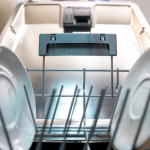An introduction to the problem of suspended ceilings cannot do without mentioning such a common problem as the accumulation of moisture above the canvas. However, if you are interested in how to drain water from a stretch ceiling yourself, in this article we will reveal safe and proven methods.
Common problems and their consequences
Stretch ceilings have become a part of our everyday life due to its aesthetics and functionality. But for all their beauty and convenience, they can cause a lot of trouble. The accumulation of water above the canvas not only threatens its integrity, but also poses the danger of mold development and interference with the electrical safety of the room. That is why knowing how to remove water from a suspended ceiling if it is flooded on your own is especially important for every owner of such a ceiling.
Reasons for water getting on a suspended ceiling
Water on a suspended ceiling may appear for various reasons:
- Leak due to damage to communications: As a rule, pipes hidden behind the ceiling sheet can become a source of leakage.
- Moisture after fire extinguishing or flooding from above:If an accident occurs in the form of flooding from neighbors, it is important to know how to drain water from a suspended ceiling yourself through a lamp in order to minimize damage.
- Condensation and its influence: Temperature changes or high humidity lead to the formation of condensation between the main ceiling and the tension fabric, which may require action to remove it.
Preparation for removing water from ceiling
The set of tools and materials includes:
- Rubber gloves and goggles for safety.
- A container for collecting water so that nothing spills on the floor .
- A soft cloth or sponge to gently apply to the canvas.
Precautions before starting work:
Before you begin work to remove water , turn off the electricity in the room to avoid accidental short circuits and protect equipment and furniture from water.
| Step | Precaution |
|---|---|
| 1 | Turn off electricity in the work area to avoid electrical injury. |
| 2 | Wear a protective suit and rubber boots to avoid contact with contaminated water. |
| 3 | Use safety glasses and a face mask to prevent entry of water and dust into the eyes and respiratory tract. |
| 4 | Make sure the ladder or lifting equipment you are using is in good condition and safe to use. |
| 5 | Work with a partner or colleague so you can provide assistance when needed. |
| 6 | Carry a first aid kit and knowledge of basic emergency response techniques. |
| 7 | Before you begin When working, make sure the area is well ventilated or use a product to remove harmful fumes. |
| 8 | Follow the instructions and recommendations of workplace safety professionals. |
Step-by-step instructions for removing water without damaging the ceiling
In order to avoid punctures and maintain the integrity of the canvas, consider a method of how to drain water from a stretch ceiling yourself through puncture without causing damage:
- Prepare a place for draining the water by placing a suitable container in the required location.
- Gently press the blade where it sags the most, directing the flow water into the container.
- Use a soft cloth or sponge to reduce the risk of damage to the stretch ceiling.
Further actions after removing the water
Treatment surfaces to prevent mold and mildew
After water removal is completed, the surface must be thoroughly dried. Use a hair dryer or other means to dry quickly. Then treat the surface with an antiseptic to prevent the growth of mold and mildew.
Repair and restoration of the ceiling canvas
If minor damage to the canvas was discovered during water removal, it is necessary to repair them. In case of serious damage, you should consider replacing the canvas or contact professionals to repair it.
- Elimination of minor deformations.
- Repair or replacement of a segment of the canvas in case of significant damage.
When to turn to professionals
If all attempts to independently solve the problem have not led to success or if the amount of work is off scale, it is recommended to seek help from specialists. Professionals will quickly and effectively diagnose the problem and offer optimal solutions.
- Difficulty in determining the source of the leak.
- The presence of significant damage and sagging of the canvas.
Conclusion: maintaining the quality and aesthetics of the stretch ceiling
In conclusion, it is worth emphasizing once again that a timely response to the problem of water accumulation on the stretch ceiling and the correct actions to eliminate it will help maintain the integrity, aesthetics and performance characteristics of the canvas . By following this guide and the advice of professionals, you can avoid many troubles and extend the life of your stretch ceiling.
Frequently asked questions:
-
Can I remove water from a stretch ceiling yourself?Yes, following the instructions, you can remove water from a stretch ceiling yourself, but it is important to follow safety and accuracy measures so as not to harm the material.
-
How quickly should you act when you detect water on the ceiling? It is recommended to act as quickly as possible to prevent more water accumulation and possible destruction and stretching of the canvas.
-
Can stains remain after draining water from the ceiling?Stains may appear if the water has stood for long enough. In this case, the ceiling requires additional cleaning or repair.
-
What to do if the suspended ceiling is severely damaged due to water? In case of serious damage, contact contact specialists for consultation and possible repair or replacement of the canvas.
-
Does the formation of condensation affect a suspended ceiling? Yes, the accumulation of condensation can lead to damage to the ceiling and requires prompt action to remove it and prevent further formation.
“

